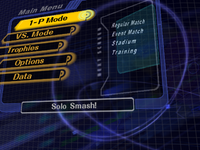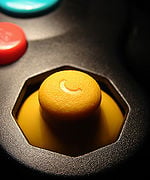| Welcome to SmashWiki! Log in or create an account and join the community, and don't forget to read this first! |
| Notices |
|---|
| The Skill parameter has been removed from Smasher infoboxes, and in its place are the new "Best historical ranking" and "Best tournament result" parameters. SmashWiki needs help adding these new parameters to Smasher infoboxes, refer to the guidelines here for what should be included in these new parameters. |
| When adding results to Smasher pages, include each tournament's entrant number in addition to the player's placement, and use the {{Trn}} template with the matching game specified. Please also fix old results on Smasher pages that do not abide to this standard. Refer to our Smasher article guidelines to see how results tables should be formatted. |
| Check out our project page for ongoing projects that SmashWiki needs help with. |
C-Stick
- Not to be confused with the Control Stick.
The C-Stick is the yellow analog stick on the right side of the GameCube controller and on the top of the right side of the New Nintendo 3DS. In Super Smash Bros. Melee's versus mode and in Super Smash Bros. for Nintendo 3DS, it can be used to perform any smash attack while standing, or any aerial attack while in midair. With the option to customize controls in Super Smash Bros. Brawl and Super Smash Bros. for Wii U (Smash 3DS doesn't allow to customize the C-stick), the C-stick can also be assigned many other control behaviors, such as inputting tilt attacks (A-sticking) or special moves (B-sticking). The right Control Stick on the Wii U GamePad and Classic Controllers also works like the C-stick for the Smash games these controllers are compatible with.
Smash attacks inputted with the C-stick are performed one frame slower than the fastest possible, though this has little to no effect on its usefulness. If one presses a grab button right after the player tilts the stick, they can charge the smash attack. It is also possible to charge a smash attack by pressing an attack button when tilting the C-stick, in the same manner the player would if they were using the Control Stick, or in Super Smash Bros. 4, by simply holding the C-stick in the direction it was tilted. The C-stick can also be used to perform aerial attacks, in which case the attack will be performed in the direction the C-stick is tilted, allowing the player to do an aerial while moving in another direction without losing momentum, such as a back aerial or up aerial while moving forward. In all games, the C-stick can substitute the Control stick in some instances, as it can be used to roll or sidestep out of shield, determine the direction of a tech, and aid in directional influence (both DI and SDI). The C-stick is additionally notable as the means to perform a DACUS and other advanced techniques.
In Melee's single player modes, the C-stick can be used to change the zoom distance of the camera, by tilting it up to zoom in and down to zoom out. This is essentially pointless, as the camera control cannot do much other than restrict the player's view, and players fond of using the C-Stick to attack will find themselves instead taking no action.
From Brawl onwards, functions that can be assigned to the C-stick are:
- Smash: (Default) Smash attack short cuts, just like in Melee. In Smash U, holding the stick also allows to charge the smash attack.
- Aerial: While in midair, the player can tilt the C-stick in any direction to perform an aerial attack. In Brawl, a downward press will also cause fastfalling, which can aid in vertical momentum canceling.
- Grab: Tilt the stick to grab. After grabbing a foe, tilting it again produces pummels. The direction in which the player tilts the stick does not affect grabbing or pummeling.
- Shield: Tilt the stick to put up the character's shield, and release it to drop the shield. Not affected by the direction the stick is tilted. Can also be used to air dodge.
- Jump: Tilt the stick to jump. Not affected by the direction the stick is tilted.
- Special: Tilt the stick to do the special that corresponds to that direction. This is known as B-sticking. Tilting the stick in one horizontal direction while holding the control stick in the other causes wavebouncing. In addition, tilting the stick diagonally allows a neutral special, though the angle required for this is very strict.
- Attack: Shortcuts to tilt attacks, and aerial attacks just like with the Smash function when in midair. In Brawl, tilting the stick in the direction opposite the player is facing will cause the character to do a neutral attack, whereas in Smash U, the fighter will turn around and attack with their forward tilt. Known as A-sticking. In both games, tilting the C-stick in a diagonal angle produces neutral attacks on the ground and neutral aerials in midair, with a wider angle than that do to neutral specials with the Special function: as such, this function also enables players to use neutral aerials without losing momentum.
- Dash attack: While dashing, tilting the C-stick in any direction produces a dash attack, allowing to use it immediately after dashing, instead of the forward smash produced by the A Button.

In Melee and Brawl, the player can also use the C-stick to change the camera angle on the various menus within the game.
Super Smash Bros. may be played through the Virtual Console using a GameCube controller. When doing this, the C-Stick will be mapped to the N64 controller's C buttons, used to jump.
Techniques
These are some techniques that can be performed with the C-Stick that cannot be performed using the Control Stick and attack button.
Aerial attacks in opposite directions
Using the C-Stick, the player is able to move through the air in one direction, but input their aerial attack in another direction. For example, a player could move right, but their attack could be inputted so its hitboxes are on the left side.
Smash DI
Smash directional influence can be performed by using both the Control Stick and the C-Stick. By using both joysticks together, the player can SDI at a much farther distance than possible with just one stick.
Aerials without moving
Using the Control Stick to perform a forward aerial or back aerial will result in the player moving slightly in the direction inputted. However, the C-Stick does not require a direction on the Control Stick to attack with an aerial, so when used with the C-Stick, the player will not move horizontally. Good for countering approaches.(In SSBU C-stick aerials will cause you to drift horizontally)
Mashing out of grabs (Brawl)
In Super Smash Bros. Brawl, the C-stick counts as two inputs in the grab escape formula, letting the player escape quicker from grabs by mashing with the C-stick.
Trivia
- In Brawl, the C-Stick can be used to perform up tilts, down tilts, and special moves, even when the C-Stick is set to Smash. The player must simultaneously press the direction on the C-Stick and the Control Stick, special move button, or shield button.
- Back in Melee's early tournament years, the C-stick was contemptuously called the "cheap stick" since it made it much easier for players to use aerial attacks, especially with Marth, which led to a negative image of him due to his overreliance on them.
- In Smash 4, if the C-stick is set to Smash, it inputs a move until it is returned to neutral position. This allows smash attacks to be charged but prevents any other move to be inputted and removes aerial momentum when using aerials until the C-stick is released. This does not happen with the C-stick set to Attack because every input is only registered for a single frame.
| hide Controllers and buttons | |
|---|---|
| Nintendo 64 controller | |
| GameCube controller | |
| Wii Remote (and Nunchuk) | |
| Classic Controller | L |
| Nintendo 3DS | |
| Wii U GamePad / Pro Controller | L |
| Joy-Con | |
| Switch Pro Controller | L |
| Third-party controllers | Hori Mini Pad · Arcade controller · Keyboard |
| Other | Smash Controller · Controller modification |


